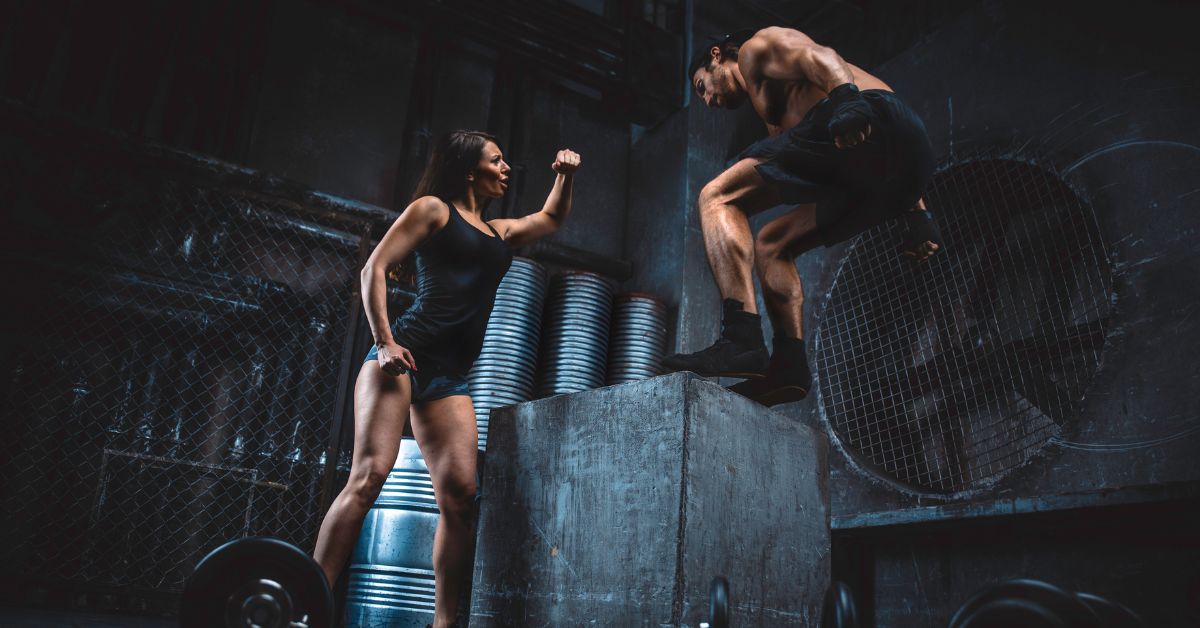Functional strength training is a combination of endurance, strength, mobility, and fat loss.
Table of Contents
ToggleThese workouts are different because the goal is not to develop the largest muscles or reduce the most body fat. Instead, it would be best if you focused on developing a foundational level of functional strength and mobility that will enable you to perform the other workouts you require.
This implies that there will be a limited amount of lifting heavy weights or doing challenging cardio exercises. But remember that light-weight and bodyweight exercises can still be exhausting.
Start Building Your Dream Body Today
Ready to elevate your fitness game without falling into the trap of dull, repetitive routines that just don’t deliver? Imagine sculpting your ideal physique and boosting your health, all while still enjoying life’s pleasures, like those irresistible weekend getaways and your aunt’s legendary cheesecake. With our online fitness and nutrition coaching service, you don’t have to compromise. Dive into a personalized fitness journey that blends perfectly with your lifestyle, not against it. Book your completely free discovery consultation today, and take the first step towards a transformation that doesn’t require giving up the joys of life.

“I was skeptical about online fitness coaching, but Functional Body Savage completely changed my perspective. Vanja and Radomir’s personalized approach and attention to detail have helped me achieve goals I never thought possible. I’m stronger, more confident, and grateful for their guidance.”
Emily Thompson, San Francisco, CA
Learn More About Our Online Coaching ServiceQuick Summary
- Functional training aims to imitate the movements you must do every day and practice them for a set amount of time each day.
- These ten exercises will improve your range of motion, body awareness, and all strength.
- Functional strength training may slow down the effects of age-related muscle atrophy and decrease your risk for injury.
How Do I Become More Functionally Strong?
You can become more functionally strong by concentrating on the entire body and particularly developing and strengthening your core.
You’ll be able to complete daily tasks more successfully and effortlessly if you participate in functional strength training.
For example, let’s say you easily get exhausted while doing your regular activities or cannot carry out some easy tasks that others can easily do. You should then begin to functionally train instead [1].
You’ll have more energy and be able to carry out all the required tasks. Additionally, it will improve your quality of life and reduce your risk of injury, even for athletes [2].
Functional training aims to imitate the movements you must do every day and practice them for a set amount of time each day. Simple activities like squatting and carrying weights make up functional strength training.
10 Exercises to Improve Functional Strength
We want to provide you with ten fantastic, valuable, attempted functional exercises to enhance your functional strength.
They will improve your range of motion, body awareness, and all strength. You can argue about the order, but including the moves on this list in your programming will make you more flexible and fitter.
1. One Arm Dumbbell Bench Press

One arm dumbbell bench press is a chest exercise that belongs to the horizontal push movement pattern. It activates muscles such as the triceps, delts, pecs, and even core muscles.
How to Perform One Arm Dumbbell Bench Press
- Using a flat platform for the single-arm dumbbell bench press is best.
- Plant your feet firmly on the ground and arch your back slightly while pulling your shoulder blades in and down. Maintain this position as you would for a regular bench press.
- Retract your shoulder blades and keep your feet firmly on the ground.
- Control the dumbbell’s descent until the upper arm is parallel to the ground.
- Drive the opposite leg into the ground and brace your core firmly as you press back up to the fully extended arm position. To properly maintain both shoulder blades tucked and offer as much stability as possible, keep the non-working arm fully extended.
2. Squat
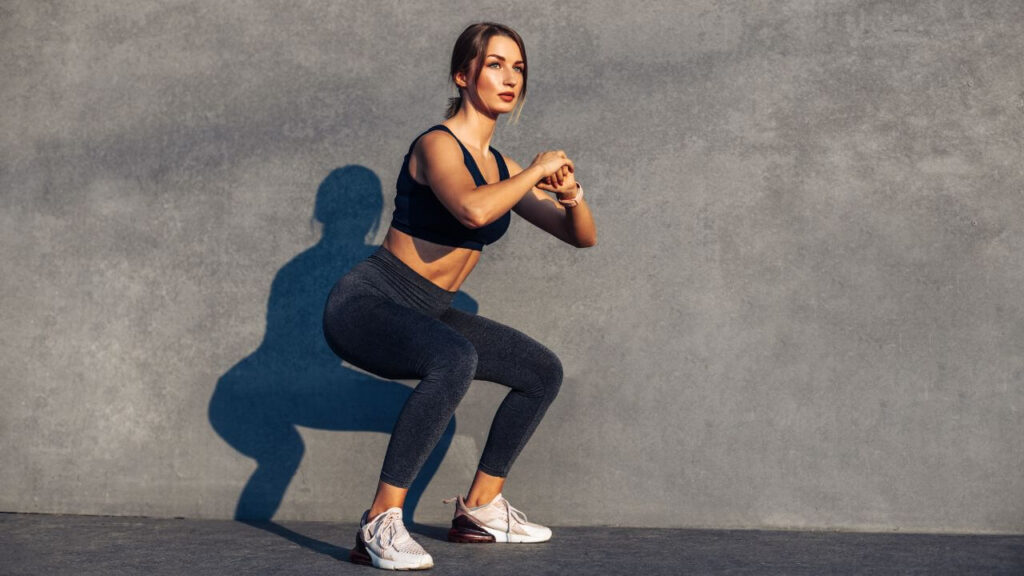
Squat is an excellent exercise for legs that belongs to the squat movement pattern. It activates muscles such as the quadriceps, hamstrings, and glutes.
How to Perform a Squat
- Although everyone’s stance will differ, a recommendation is that your feet be between hip- and shoulder-width apart, with your toes, turned slightly outward. With your shoulders down and back and your chest out and tall, your back should be neutral. Be sure to maintain a firm heel position. You can hold hands in front of your chest for balance.
- Send your hips back as if you were sitting in an unseen chair to begin the exercise. Bend your knees and drop as far as you can while keeping your chest up. Neutralize your lower back. To get back to the beginning position, lift your heels. Repeat.
- Get your thighs to be at least parallel to the ground. Squat, so your thighs are parallel to your knees to achieve this. If mobility allows, lower further. Make sure your hips are just underneath your ribs as you stand back up; you don’t want your hips to pull back too far.
3. Dead Bug

Dead bug is a great exercise that focuses on core fixation and anti-extension. It activates muscles such as transverse abdominis, pelvic floor, and obliques.
How to Perform a Dead Bug
- Lie on your back with your feet up, and your knees bent at a 90-degree angle with your toes pointed upward.
- Extend your arms toward the ceiling. Right now, you resemble a dead bug.
- Flatten your lower back by performing a posterior pelvic tilt. Maintain this the whole time.
- Inhale deeply through the nose, feeling 360-degree expansion.
- Breathe with your back firmly planted on the ground while simultaneously extending your left arm and right leg in front of you.
- Return to the starting position and repeat on the other side.
4. Side Plank
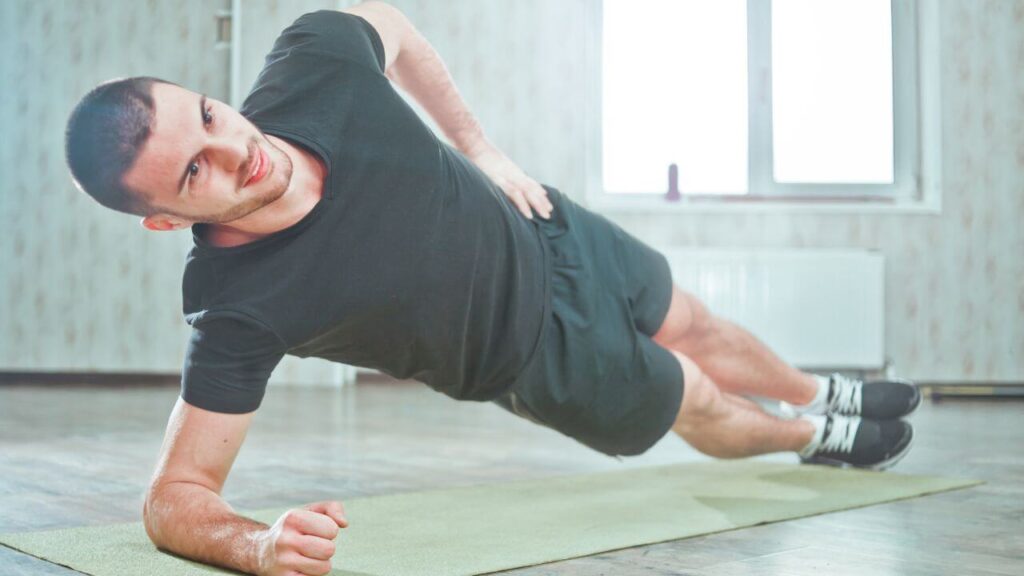
Side plank is an exercise that belongs to anti-lateral flexion movement patterns. It activates muscles such as your obliques.
How to Perform a Side Plank
- To bring your navel closer to your spine, contract your abdominal muscles.
- Exhale as you raise your knees and hips off the mat. There is no slumping or bending in your torso, which is straight. Hold the position.
- Inhale after a few breaths, then push yourself back to the beginning position. The target time should be 1 minute. Swap sides and do it again.
5. Single Arm Dumbbell Row
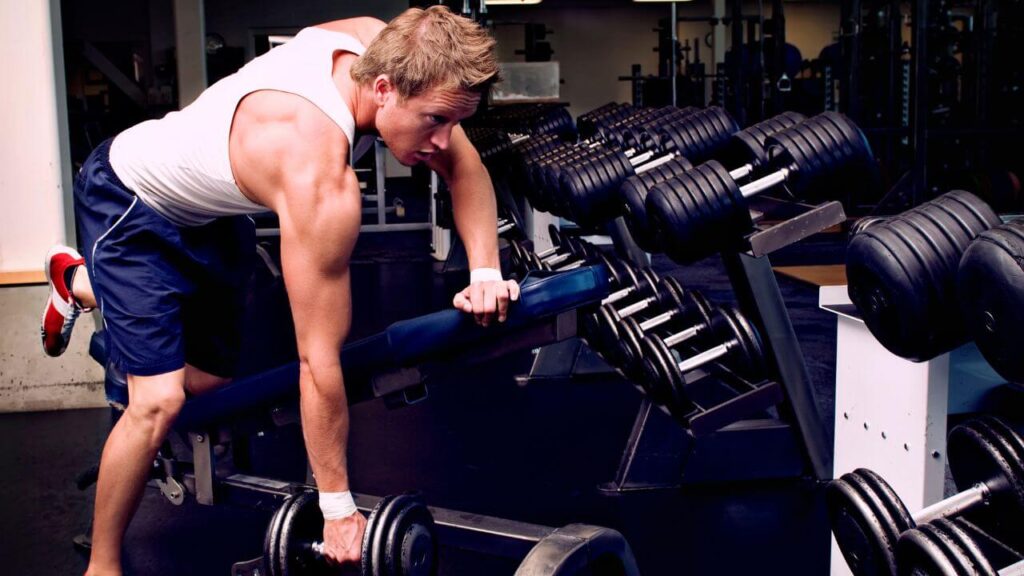
Single arm dumbbell row is an excellent exercise that belongs to horizontal pull movement patterns. It activates muscles such as the posterior deltoid, rhomboid, and trapezius.
How to Perform a Single Arm Dumbbell Row
- Assume a standing position and hold a dumbbell with a neutral grip in one hand.
- Your torso should be about parallel to the floor as you bend (or slightly above). Drive the elbow behind the body and retract the shoulder blade to initiate the exercise.
- Pull the dumbbell until the elbow is at (or just past) the midline, and then gently and carefully return it to the starting position.
- Repeat on both sides for the desired number of times.
6. Single Leg Deadlift
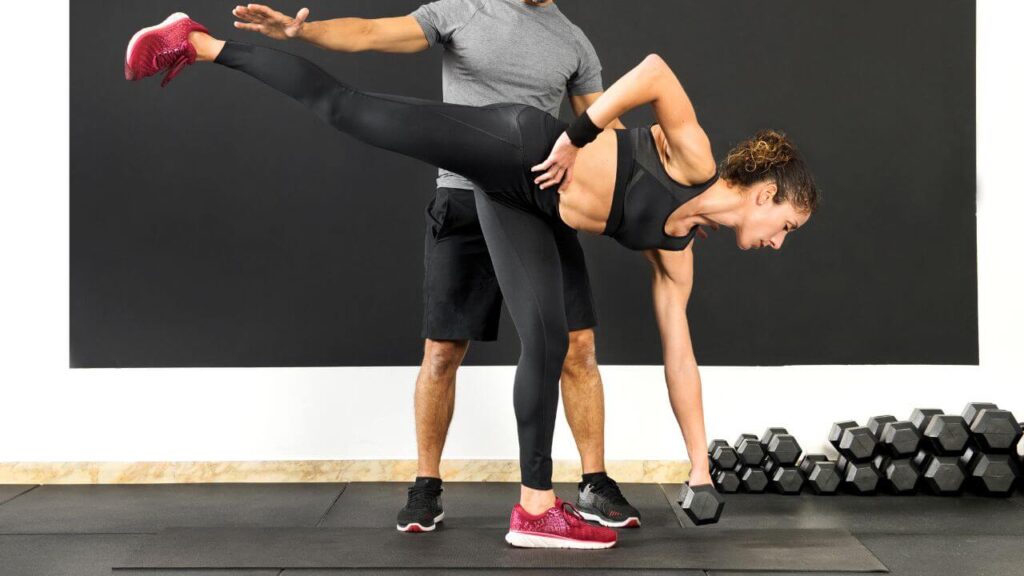
Single leg deadlift is a great exercise that belongs to deadlift movement patterns. It activates muscles such as the glutes, hamstrings, lower back, and core muscles.
How to Perform a Single Leg Deadlift
- Start by standing with your feet parallel and hip-width apart. In front of you, hold a kettlebell in your hands.
- Leaning forward with your hips, place all your weight on one leg as the other engages and begins to extend behind you.
- Lift the extended leg after your body is in a position that creates a “T” shape. Your arms must be hanging straight down while you are holding the weight. Maintain a slight bend in your standing leg.
- Slowly return to your starting posture with your extended leg. Do the same with the other leg.
7. Dumbbell Overhead Press

Dumbbell overhead press belongs to the vertical push movement patterns. It activates muscles such as the medial deltoid, anterior deltoid, triceps, and rotator cuff muscles.
How to Perform a Dumbbell Overhead Press
- Hold two dumbbells in your outstretched arms next to your torso.From here, you will ‘raise’ the dumbbells onto your shoulders. Get them into the starting position by using controlled momentum.
- Take a deep breath, hold it, and squeeze your glutes to initiate the movement. Start lifting the dumbbells above while keeping a straight line with your elbows.
- Press the weights as straight-ahead and overhead as you can. Lower the weights back down until they are in touch with your shoulders to reverse the movement.
8. Pull up
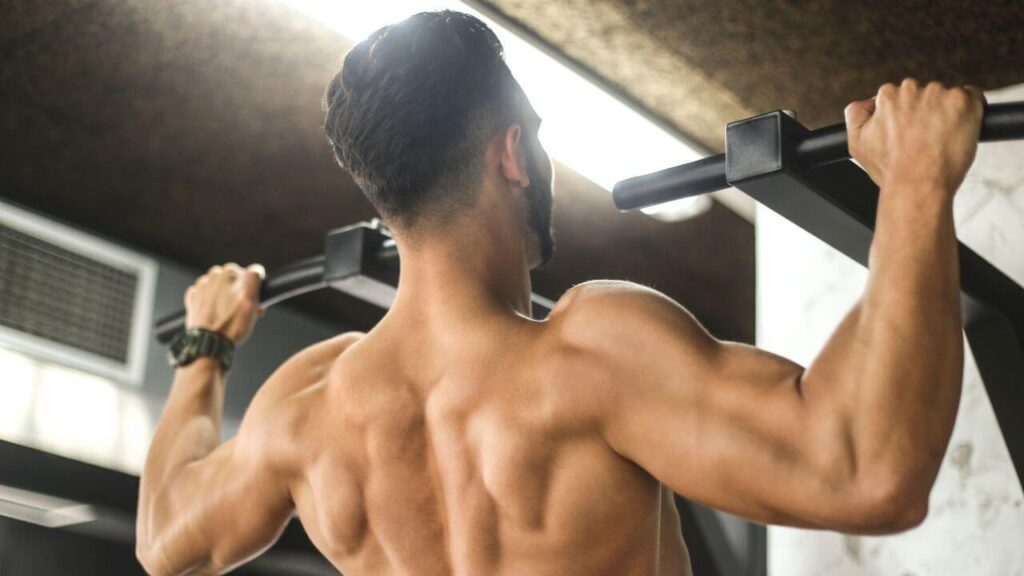
Pull up is an excellent exercise that belongs to vertical pull movement patterns. It activates muscles such as your lats and biceps.
How to Perform a Pull up
- Start by placing your hands on the bar with your palms facing front and about shoulder-width apart.
- Extend your chest and slightly bend your back while lifting your arms.
- While exhaling, pull yourself up toward the bar until the bar is at chest height.
- While inhaling, slowly return to the beginning position.
9. Pallof Press

Pallof press is a great exercise for strengthening your core musculature. It focuses on stabilizing your core and the ability to prevent the movement of your spine.
How to Perform Pallof Press
- Take a band and wrap it around a pole.
- Stay a few steps away from the pole with the band in your hands, tucked on your chest.
- Your body should be aligned with the pole, meaning it should be turned 90 degrees away from it, on either side.
- Take an athletic stance and slowly perform band extension, hold for a second, and then reverse the movement.
10. Standing Band Rotation
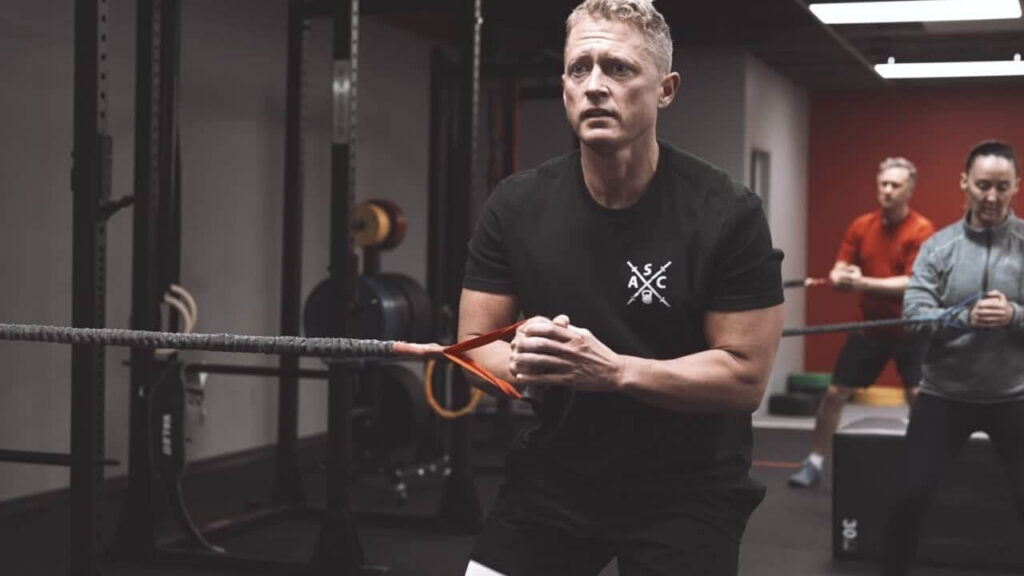
Standing band rotation is an excellent exercise that is focused on rotation in the transverse plane. It activates muscles such as the glutes, abs, groin, and hamstrings.
How to Perform a Standing Band Rotation
- Start by wrapping a band around a pole or another object that will allow it to be at chest level.
- Face the pole while standing upright. Your body’s left side should be parallel to the pole.
- With both hands, grab the resistance band. Hold the band in the middle of your chest with your arms straight.
- Twist externally while pulling the resistance band in front of you using your upper glutes.
- Repeat on the opposite glute and for the desired sets.
Functional Movements in Daily Life
Functional movements are felt the most during an active and busy day. On those kinds of days, your body is constantly in some movement. Some of the most common ones are:
- Squat – Stand up and sit down
- Single leg movement – walking, stairs
- Upper body pull – Pickup your groceries from the car
- Upper body push – Load groceries into your car
The key to functional training is to develop usable strength – Michael Boyle, Strength and Conditioning and Strength Training Consultant
Related Posts:
- 10 Best Gymnastic Rings for Bodyweight Functional Strength
- Can Functional Training Build Muscle?
- Does Functional Training Burn Fat?
- Is Functional Training Effective?
FAQs
Can You Build Muscle With Functional Strength Training?
Yes, you can build muscle with functional strength training. It helps with growing muscle and full-body strength. The benefits of functional strength training are improving your mood, increasing your metabolism and ability to burn calories, and supporting overall health.
What Is the Difference Between Traditional Strength Training and Functional Strength Training?
The difference between traditional strength training and functional strength training is that traditional strength training will increase strength but not affect other systems. Functional strength training focuses on something different than strength, increasing their efficiency for activities faster than traditional training.
Is Bench Press Good for Functional Strength?
Yes, bench press is good for functional strength. It is crucial to develop the maximum strength needed to perform functional movements required in sports and day-to-day life.
Why Is Training for Functional Strength Important?
Functional strength training may slow down the effects of age-related muscle atrophy and decrease your risk for injury.
This can be applied not only to people that are not professionals but also to athletes. Try doing several of the exercises above to work your functional strength.
By adding just 2-3 days of functional strength exercises a week, you should see improvements in your ability to perform your everyday activities.
Start Building Your Dream Body Today
Ready to elevate your fitness game without falling into the trap of dull, repetitive routines that just don’t deliver? Imagine sculpting your ideal physique and boosting your health, all while still enjoying life’s pleasures, like those irresistible weekend getaways and your aunt’s legendary cheesecake. With our online fitness and nutrition coaching service, you don’t have to compromise. Dive into a personalized fitness journey that blends perfectly with your lifestyle, not against it. Book your completely free discovery consultation today, and take the first step towards a transformation that doesn’t require giving up the joys of life.

“I was skeptical about online fitness coaching, but Functional Body Savage completely changed my perspective. Vanja and Radomir’s personalized approach and attention to detail have helped me achieve goals I never thought possible. I’m stronger, more confident, and grateful for their guidance.”
Emily Thompson, San Francisco, CA
Learn More About Our Online Coaching ServiceReferences:
- https://www.mdpi.com/2071-1050/13/3/1074
- https://pubmed.ncbi.nlm.nih.gov/33177735/

